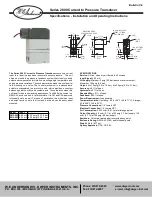
Safety
- 4 -
®
Affinity LBD-200C-N1 Transmitter
Product Manual
3.3 Safety Symbols
Assemblies within the transmitter system that contain high voltage conditions have safety
symbols attached to them.
HIGH VOLTAGE
This symbol identifies the presence of high voltage that can cause injury or death.
3.4
Electrical Shock and the Human Body
Electrical shock or electrocution occurs when the body becomes part of an energized electrical
path and this electrical energy passes through the body.
The body subjected to a difference of potential, or stored electrical charge causing current to
flow through the body, will be shocked or electrocuted. Effects of electrical shock may include
severe burns to the skin and/or internal organs and respiratory or cardiac arrest. Any electrical
current that flows through the central nervous system of the human body has the potential to
cause serious injury or death.
Severity of electrical shock depends upon the source and duration of exposure. Use the
following information in conjunction with a vigilant and on-going safety program. This information
is in general terms and does not include unknown variables that may increase susceptibility to
electrical shock. Always exercise
Awareness and Caution
.
Direct Current (DC)
: Low voltage (up to 72 V
DC
) usually does not present a hazard to human
life, but a severe burn is possible under some conditions. Medium and high voltage (greater
than 72 V
DC
) can cause severe shocks, burns, and even death.
Alternating Current (AC)
: At commercial frequencies (50-60 Hz) and intermediate voltages (72
to 600 V
AC
), lethal current can flow through the body. Even low AC voltages (24 V
AC
or less)
under certain circumstances can be dangerous and lethal. The danger of shock is less at high
frequencies, but radio-frequency (RF) burns are possible.
Body Resistance
: The resistance of the body and the amount of insulation between the body
and electrical earth-ground determine the amount of electrical current that passes through the
body. The skin presents the greatest resistance of the human body to impede current flow.
Please note that s
kin resistance decreases with increased voltage
.
Time of Contact
: The length of time the body remains in contact with electrical current
determines the severity of possible injury. Burns break down the skin and thus lowers the body’s
ability to resist electrical current. The more extensive the burn, the less resistance the skin
provides. As current flow increases, so does the severity of the shock. The duration of contact is
critical. Current flowing through the body causes loss of muscle control, chest contractions
(breathing is impaired) and ventricular fibrillation of the heart. During fibrillation, the heart cannot
pump sufficient quantities of blood.
Magnitude
: The magnitude of the electrical current determines the extent of muscle-control
loss, effects on the heart, and severity of burns.











































